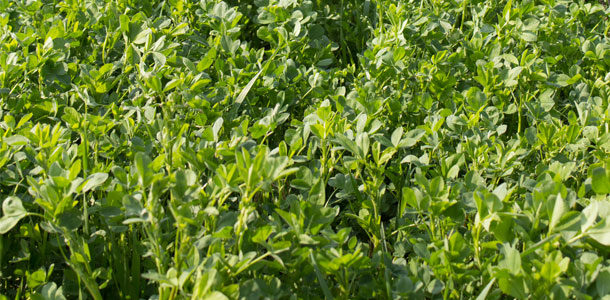Whether mechanically harvested or grazed, most forages are managed with the goal of maximizing protein content. However, much of that sought-after protein is ultimately not used by livestock for the production of milk or meat.
This is because a high proportion of protein in forages such as alfalfa undergoes proteolysis (breakdown) to form non-protein nitrogen products during haymaking, or especially ensiling, and also during ruminal digestion.
Although a large portion of this non-protein nitrogen can be converted to nutritionally valuable microbial protein in the rumen, excessive levels are excreted in urine mainly as urea, which is readily converted and lost to the environment as ammonia.
Typically, 30 percent or more of the protein in alfalfa-based diets is ultimately excreted as urinary nitrogen, and only about one-third of the original protein in alfalfa undergoes partial digestion in the gastrointestinal tract to supply amino acids for supporting growth and milk production.
 Identifying methods to increase the proportion of forage protein digested in the gastrointestinal tract would improve protein-use and nitrogen-use efficiency (NUE), enhance farm profitability and lessen ammonia emissions from farms to the environment.
Identifying methods to increase the proportion of forage protein digested in the gastrointestinal tract would improve protein-use and nitrogen-use efficiency (NUE), enhance farm profitability and lessen ammonia emissions from farms to the environment.
Some forages like birdsfoot trefoil and sainfoin contain condensed tannins (CTs), which are natural protein-binding substances that limit proteolysis during conservation and ruminal digestion.
Modest amounts of CT (1 to 3 percent of dry matter) in forage often increase the amount of protein digested in the hindgut to boost milk production and weight gain of livestock.
Through the prudent use of CT-containing forages, significant impact on dairy farm incomes and NUE are likely.
For example, preliminary estimates generated by the Integrated Farm System model indicate the production and feeding of a CT-containing alfalfa would increase profits of U.S. dairy farms by at least $300 million per year and reduce nitrogen losses from these farms by up to 25 percent.
Excessive amounts of CT can, however, adversely affect livestock production by depressing the intake of feed and the digestion of protein and other nutrients.
Scientists at the USDA Agricultural Research Service’s U.S. Dairy Forage Research Center (USDFRC) and other institutions are working to identify the optimal concentration and chemical characteristics of CT for maximizing livestock production and the overall profitability and protein-use and nitrogen-use efficiency of farms. Some of the active research currently includes the following.
Improve CT measuring

One aspect of research is to develop more accurate, routine methods for measuring CTs and their effects on protein digestibility. Scientists at USDFRC and the University of Reading in the United Kingdom are working to improve the accuracy of the widely used butanol-HCl assay for measuring CT concentrations in forages.
Other work is aimed at evaluating and improving laboratory assays for predicting the ruminal and gastrointestinal degradability of protein in CT-containing forages. Widespread use of these assays will ensure that diets are optimally formulated to make best use of CT-containing forages.
Identify optimal CT characteristics for forages
USDFRC scientists, in collaboration with scientists at the University of Reading, have developed techniques to purify a wide variety of CTs from forages such as birdsfoot trefoil, big trefoil, sainfoin, lespedeza and white clover, and from non-forage sources such as cocoa, sorghum seed and woody plants.
Powerful analytical techniques such as “nuclear magnetic resonance” and “thiolysis” are being used to characterize the composition and structure of isolated CT.
These CTs are being used in various laboratory assays to identify the optimal characteristics of CT for limiting proteolysis during forage conservation and ruminal digestion while permitting extensive digestion of forage protein in the gastrointestinal tract.
Reduce nitrogen loss from farms
Forage CT or commercial CT products added to diets of dairy cows can reduce urea excretion in urine and inhibit the enzyme urease, which is responsible for the conversion of urea to ammonia in manure.
Scientists at USDFRC and the University of Wisconsin – Madison have found that CT-containing diets reduce ammonia loss from dairy barn floors and from soils after manure slurry application. Other studies have or will examine whether CT can enhance the utilization of nitrogen in crop rotations.
Developing or improving CT-containing forage crops
USDFRC scientists are working with Forage Genetics International to characterize alfalfa that has been bio-engineered to produce CT in its leaves. USDFRC scientists are also using traditional breeding methods to improve birdsfoot trefoil for use on conventional or organic grazing-based farms.
Best management practices will also be identified to help ensure that farmers can reliably grow and feed high-quality CT-containing forages to livestock. FG
Wayne Zeller is a research chemist and John Grabber is a research agronomist with the USDFRC in Madison, Wisconsin, which is a part of the USDA Agricultural Research Service. The authors would like to acknowledge the contributions of J. Mark Powell in the preparation of this article.
Wayne Zeller and John Grabber
USDA Agricultural Research Service










